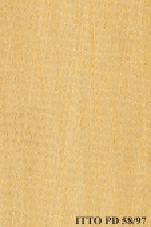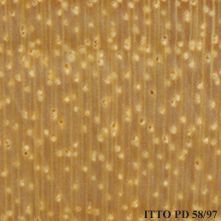
AVODIRé (Turraeanthus africanus)
Trade Name
Avodiré
Scientific Name
Turraeanthus africanus (Welw. ex C. DC.) Pellegr.
Family
MELIACEAE
Common Names
Avodire (Côte d`Ivoire); M'Fube (Zaire); Lusamba (Zaire); Lusamba (Belgium); M`fube (Zaire); Apaya (Nigeria); Blimah-pu (Liberia); Apapaye (Ghana); Avodire
Scientific Name Synonyms
Turraeanthus zenkeri Harms; Turraeanthus vignei Hutch. & Dalziel; Guarea africana Welw. ex C. DC.; Bingeria africana (Welw. ex C. DC.) A. Chev.
Description Of The Tree
Botanical Description
The tree reaches a height of 38 m. The bole is usually irregular, fluted, clear to 16 m in length. The trunk diameter attains 70 to 100 cm.
Natural Habitat
Turraeanthus africanus is commonly found in the rain semi-deciduous forests, in a narrow semi-coastal belt among foothills and near streams and lakes, often in poorly drained places.
Natural Distribution
West Africa, from Sierra Leone to Angola and the Democratic Republic of the Congo.
Wood Identification
Anatomic Description Of Wood
Wood diffuse porous. Occasionally vessels exclusively solitary (over 90%). Tangential diameter of vessel lumina 100 to 150 micras (small). Non-vestured pits. Vessels per mm2 10 to 20 (abundant). Simple perforation plates. Vessel-ray pits similar to intervessel Paratracheal axial parenchyma scanty and/or vasicentric. Prismatic crystals in chambered axial parenchyma cells and/or in fibers. 3 to 4 cells per parenchyma strand. 4 to 10 rays per mm (medium). Rays non-storied. Rays commonly 2 seriate. Homogeneous rays and/or sub-homogeneous rays (all ray cells procumbent). Body ray cells procumbent with one row of upright and/or square marginal cells (Kribs-III). Non-septate fibers. Fibers with simple to minutely bordered pits.
-
 Wood Macro Photo Tangential Plane
Wood Macro Photo Tangential Plane
-
 Wood Micro Photo Of Transversal Section
Wood Micro Photo Of Transversal Section
Availability
Cites Status
Unrestricted
General Wood Description
Color
The heartwood is creamy white to pale yellow, darkening to golden yellow on exposure, it is not clearly demarcated. The silver figure is fine.
COLOR INDEX (1=Black, 7=Light yellow,white)
7
Grain
Straight or slightly interlocked, sometimes with an influence on further processing operations.
Texture
This wood has a somewhat fine texture.
Luster
The wood surface is described as high in luster.
Natural Durability
Not durable; important risks of decay attacks at any processing step, from logs up to final products. It must receive preservative treatment. Moderately resistant to termites attack. The heartwood is sensible to Lyctus attacks.
Natural durability index (1= Very high durability, 7=Vey low durability)
5
Internal Growth Stresses
For this species no growth stresses are reported.
Silica Content
Silica Content: This timber is reported to have a negligible silica content. Silica contents over 0.05% may affect wood processing. Silica Value: 0.01
Resistance To Impregnation
Nearly impossible to treat with a too much low penetration of the preservative substances.
Wood Physical Properties
Basic Density or Specific Gravity (O.D. weight/vol. green) (g/cm³)
0.53
Air-dry Density (Weight and volume at 12%MC) (g/cm³)
0.58
Total shrinkage Tangential (Saturated to 0%MC) (%)
6.6
Total shrinkage Radial (Saturated to 0%MC) (%)
3.9
Drying Defects
Ease of Drying: Drying is rather slow and sometimes difficult to perform. Drying Defects: Risks of distortions. Kiln Schedules: Schedule proposed as a reference by comparison with well known species taking into account to the general technological behavior of this species.
Recommended Dry Kiln Schedule
FR-5
Dimensional stability ratio (Total Tangential Shrinkage %/Total Radial Shrinkage %)
1.7
Wood Chemical Properties
Wood Mechanical Properties
Bending Strength (MOR),12%MC (kgf/cm²)
961
Stiffness (MOE) 12%MC (kgf/cm²)
128342
Compression parallel to fiber 12%MC (kgf/cm²)
532
Compression perpendicular to fiber 12%MC (kgf/cm²)
67
Shear strength radial 12%MC (kgf/cm²)
97
Janka hardness (side) 12%MC (kgf)
414
Janka hardness (end grain) 12%MC (kgf)
518
Workability
Sawing
It is easy to saw.
Rotary Veneer Cutting
Suitable for slicing.
Sliced Veneer
Suitable for slicing.
Blunting Effect
Slight blunting effect; ordinary tools can be used for sawing and machining.
Machining
Machining of this species is reportedly easy.
Planing
Easy; no particular problems.
Moulding
Moderately easy; tools must be cautiously sharpened.
Turning
30
Boring
Moderately easy; tools must be cautiously sharpened.
Mortising
Moderately easy; tools must be cautiously sharpened.
Nailing
No particular problem.
Gluing
Glues well if basic gluing technical rules are followed.
Sanding
Easy to perform; it gives good results.
Polishing
Can be polished without surface preparation.
Steam Bending
Steam bending is difficult.
Response To Hand Tools
No particular problems.
REFERENCED USES
End Uses Summary
HOUSING GENERAL, boards, frames, steps, panelling, fittings, FURNITURE AND CABINETS, luxury furniture, cabinets, PLYWOOD AND VENEER, Decorative veneer, TURNING, ornaments, turned furniture, OTHER AND MUSICAL INSTRUMENTS, moldings
General Housing
- 10 - Silica in Timbers
Boards
- 13 - Dry kiln schedules for commercial woods. Temperate and tropical. Section III. Latin American (Mexico, Central, and South America) Woods–Conventional Temperatures
Frames
- 16 - Woods of the World
Steps
- 17 - Tree Conservation Database
Paneling
- 18 - W3TROPICOS Missouri Botanical Garden
Fittings
- 19 - Silica in Timbers
Furniture Cabinets
- 21 - Tropical timbers of the world. Part III-Southeast Asian and Oceanian Species.
Furniture, Luxury
- 22 - Dry kiln schedules for commercial woods. Temperate and tropical. Section IV-Asian and Oceanian Woods
Cabinet
- 24 - Empire Timbers
Panels, Veneers
- 25 - Directory of Timber Trade Malaysia
Decorative veneer
- 28 - Ministry of Agriculture, Fisheries & Forest of Fiji
Turning
- 30 - Embassy of Honduras in Japan
Ornaments
- 31 - Embassy of Colombia in Japan
Turned Articles
- 32 - Embassy of Cote d`Ivoire in Japan
Other & Musical Instruments
- 63 - Madeiras do Brazil II
Molding
- 79 - Padronização da Nomenclatura Comercial Brasileira das Madeiras Tropicais Amazônicas, Sugestão
Please Provide Information To View Producer Information